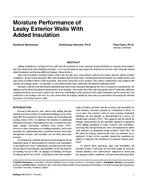Description
Adding insulation to existing exterior walls has the potential to create moisture-related problems as moisture from indoors gets into moderately leaky building envelopes. A test was designed to investigate the behavior of exterior walls with and without added insulation and having different leakage characteristics. Nine wall assemblies included within a full-scale test hut were consecutively subjected to winter and late spring weather conditions. All specimens had glass-fiber batt insulation between the studs. Extruded polystyrene boards were added on the cold side of the assembly in three of the specimens, and on the warm side in two of them. These three compositions were studied with various air leakage paths–a long path, a concentrated path, and a uniformly distributed exfiltration path. Moisture content in the fiberboard sheathing and wood studs measured throughout the test is compared to demonstrate the influence of location of insulation and geometry of air leakage. The results show that walls having the same R-value but a different composition do not necessarily behave the same way. Depending on the position of the added insulation and its properties, the sensitivity to air leakage will vary. It is also shown that air leakage should be taken into account before increasing the thermal resistance of existing exterior walls.
Authors: Guylaine Desmarais; Dominique Derome, Ph.D.; Paul Fazio, Ph.D.
Citation: Thermal Performance of the Exterior Envelopes of Buildings VIII
Keywords: December, Florida, 2001
Citation: Thermal Performance of the Exterior Envelopes of Whole Buildings VIII
Product Details
- Published:
- 2001
- File Size:
- 1 file , 550 KB
- Product Code(s):
- D-8020




